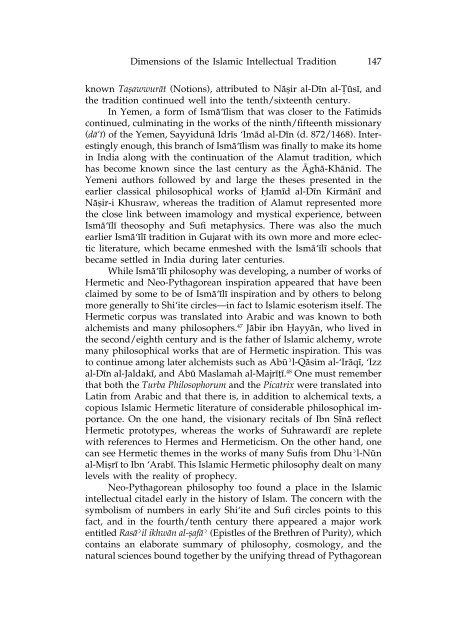Islamic Philosophy from Its Origin to the Present: Philosophy in the ...
Islamic Philosophy from Its Origin to the Present: Philosophy in the ...
Islamic Philosophy from Its Origin to the Present: Philosophy in the ...
Create successful ePaper yourself
Turn your PDF publications into a flip-book with our unique Google optimized e-Paper software.
Dimensions of <strong>the</strong> <strong>Islamic</strong> Intellectual Tradition 147<br />
known Ta„awwuråt (Notions), attributed <strong>to</strong> Nå∑ir al-D¥n al-apple¨s¥, and<br />
<strong>the</strong> tradition cont<strong>in</strong>ued well <strong>in</strong><strong>to</strong> <strong>the</strong> tenth/sixteenth century.<br />
In Yemen, a form of Ismå‘¥lism that was closer <strong>to</strong> <strong>the</strong> Fatimids<br />
cont<strong>in</strong>ued, culm<strong>in</strong>at<strong>in</strong>g <strong>in</strong> <strong>the</strong> works of <strong>the</strong> n<strong>in</strong>th/fifteenth missionary<br />
(då‘¥) of <strong>the</strong> Yemen, Sayyidunå Idr¥s ‘Imåd al-D¥n (d. 872/1468). Interest<strong>in</strong>gly<br />
enough, this branch of Ismå‘¥lism was f<strong>in</strong>ally <strong>to</strong> make its home<br />
<strong>in</strong> India along with <strong>the</strong> cont<strong>in</strong>uation of <strong>the</strong> Alamut tradition, which<br />
has become known s<strong>in</strong>ce <strong>the</strong> last century as <strong>the</strong> ≈ghå-Khånid. The<br />
Yemeni authors followed by and large <strong>the</strong> <strong>the</strong>ses presented <strong>in</strong> <strong>the</strong><br />
earlier classical philosophical works of ¡am¥d al-D¥n Kirmån¥ and<br />
Nå∑ir-i Khusraw, whereas <strong>the</strong> tradition of Alamut represented more<br />
<strong>the</strong> close l<strong>in</strong>k between imamology and mystical experience, between<br />
Ismå‘¥l¥ <strong>the</strong>osophy and Sufi metaphysics. There was also <strong>the</strong> much<br />
earlier Ismå‘¥l¥ tradition <strong>in</strong> Gujarat with its own more and more eclectic<br />
literature, which became enmeshed with <strong>the</strong> Ismå‘¥l¥ schools that<br />
became settled <strong>in</strong> India dur<strong>in</strong>g later centuries.<br />
While Ismå‘¥l¥ philosophy was develop<strong>in</strong>g, a number of works of<br />
Hermetic and Neo-Pythagorean <strong>in</strong>spiration appeared that have been<br />
claimed by some <strong>to</strong> be of Ismå‘¥l¥ <strong>in</strong>spiration and by o<strong>the</strong>rs <strong>to</strong> belong<br />
more generally <strong>to</strong> Shi‘ite circles—<strong>in</strong> fact <strong>to</strong> <strong>Islamic</strong> esoterism itself. The<br />
Hermetic corpus was translated <strong>in</strong><strong>to</strong> Arabic and was known <strong>to</strong> both<br />
alchemists and many philosophers. 47 Jåbir ibn ¡ayyån, who lived <strong>in</strong><br />
<strong>the</strong> second/eighth century and is <strong>the</strong> fa<strong>the</strong>r of <strong>Islamic</strong> alchemy, wrote<br />
many philosophical works that are of Hermetic <strong>in</strong>spiration. This was<br />
<strong>to</strong> cont<strong>in</strong>ue among later alchemists such as Ab¨˘l-Qåsim al-‘Iråq¥, ‘Izz<br />
al-D¥n al-Jaldak¥, and Ab¨ Maslamah al-Majr¥†¥. 48 One must remember<br />
that both <strong>the</strong> Turba Philosophorum and <strong>the</strong> Picatrix were translated <strong>in</strong><strong>to</strong><br />
Lat<strong>in</strong> <strong>from</strong> Arabic and that <strong>the</strong>re is, <strong>in</strong> addition <strong>to</strong> alchemical texts, a<br />
copious <strong>Islamic</strong> Hermetic literature of considerable philosophical importance.<br />
On <strong>the</strong> one hand, <strong>the</strong> visionary recitals of Ibn S¥nå reflect<br />
Hermetic pro<strong>to</strong>types, whereas <strong>the</strong> works of Suhraward¥ are replete<br />
with references <strong>to</strong> Hermes and Hermeticism. On <strong>the</strong> o<strong>the</strong>r hand, one<br />
can see Hermetic <strong>the</strong>mes <strong>in</strong> <strong>the</strong> works of many Sufis <strong>from</strong> Dhu˘l-N¨n<br />
al-Mi∑r¥ <strong>to</strong> Ibn ‘Arab¥. This <strong>Islamic</strong> Hermetic philosophy dealt on many<br />
levels with <strong>the</strong> reality of prophecy.<br />
Neo-Pythagorean philosophy <strong>to</strong>o found a place <strong>in</strong> <strong>the</strong> <strong>Islamic</strong><br />
<strong>in</strong>tellectual citadel early <strong>in</strong> <strong>the</strong> his<strong>to</strong>ry of Islam. The concern with <strong>the</strong><br />
symbolism of numbers <strong>in</strong> early Shi‘ite and Sufi circles po<strong>in</strong>ts <strong>to</strong> this<br />
fact, and <strong>in</strong> <strong>the</strong> fourth/tenth century <strong>the</strong>re appeared a major work<br />
entitled Raså˘il ikhwån al-„afå˘ (Epistles of <strong>the</strong> Brethren of Purity), which<br />
conta<strong>in</strong>s an elaborate summary of philosophy, cosmology, and <strong>the</strong><br />
natural sciences bound <strong>to</strong>ge<strong>the</strong>r by <strong>the</strong> unify<strong>in</strong>g thread of Pythagorean

















